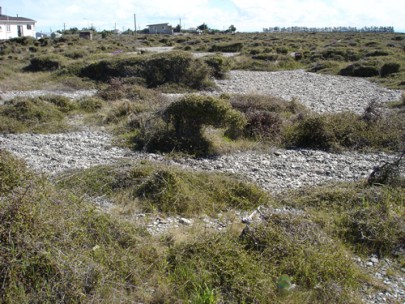Stony beach ridges
In this section
-
Coastal
- Active sand dunes
- Basic coastal cliffs
- Calcareous coastal cliffs
- Coastal cliffs on acidic rocks
- Coastal cliffs on quartzose rocks
- Coastal rock stacks
- Coastal turfs
- Dune deflation hollows
- Shell barrier beaches ('Chenier plains')
- Shingle beaches
- Stable sand dunes
- Stony beach ridges
- Ultrabasic sea cliffs

Hauroko Covenant, Birdlings Flat, Canterbury (Susan Wiser)
Stony beach ridges are former beach crests no longer influenced by wave action and comprised of wave-deposited water-smoothed gravel (particles 2-64 mm) and cobbles (64-256 mm) that are rarely disturbed by the sea. They may occur as a single ridge, or more commonly in a series of ridges becoming progressively older inland. They may be fronted by shingle beaches or shell barrier beaches. The vegetation is dominated by woody plants that form either continuous forest cover or discontinuous hummocks of shrubs. Characteristic species include kowhai (Sophora microphylla), lemonwood (Pittosporum eugenioides), mingimingi (Coprosma propinqua), thick-leaved mahoe (Melicytus crassifolius), and scramblers such as wire vine (Muehlenbeckia complexa) and leafless lawyer (Rubus squarrosus). Exposed, stable shingle is typically encrusted with lichens and bryophytes. Woody plants provide shelter for woody regeneration and for ferns such as leather-leaf fern (Pyrrosia eleagnifolia). Scattered grasses and herbs grow both in the shelter of woody plants and in open areas.
Notable flora and fauna
Threatened and rare plants include the nationally critical grey saltbush (Atriplex cinerea) and fireweed (Senecio scaberulus). Nationally endangered species include the shrubby tororaro (Muehlenbeckia astonii) and Myosotis pygmaea var. minutiflora. Nationally vulnerable species include purple plume grass (Dichelachne micrantha). Declining species include shore spurge (Euphorbia glauca), sand tussock (Poa billardierei). At-risk species include New Zealand spinach (Tetragonia tetragonioides), Senecio carnosulus) and creeping fuchsia (Fuchsia procumbens) thick-leaved mahoe (Melicytus crassifolius) and leafless pohuehue (Muehlenbeckia ephedroides). Indeterminate species include the gradually declining Raoulia aff. hookeri (AK 239529; coast). Woody cover provides high quality habitat for a number of geckos and skinks, including the nationally vulnerable spotted skink (Oligosoma aff. lineoocellatum ‘central Canterbury’) and the declining Canterbury gecko (Woodworthia cf. brunnea formerly referred to as Hoplodactylus aff. maculatus ‘Canterbury’).
Threat status
Endangered (Holdaway et al. 2012)
Threats
Stony beach ridges are susceptible to invasion by exotic plants of many life-forms including: woody plants, boneseed (Chrysanthemoides monilifera), boxthorn (Lycium ferocissimum), gorse (Ulex europaeus), Scotch broom (Cytisus scoparius), and sweet briar (Rosa rubiginosa); scramblers, blackberry (Rubus fruticosus) and smilax (Asparagus asparagoides); graminoids such as marram grass (Ammophila arenaria) and Carex divisa; succulents such as pig’s ear (Cotyledon orbiculata), ice plant (Carpobrotus edulis) and stonecrop (Sedum spp.) and herbs such as fennel (Foeniculum vulgare) and spur valerian (Centranthus ruber). These ecosystems also are favoured by lagomorphs (rabbits). Karo (Pittosporum crassifolium) is a northern North Island endemic species that is invading southern North Island and South Island. Exotic woody plants may provide protected sites for regeneration of natives from lagomorphs, so weed control should be undertaken with care.
Stony beach ridges are often readily accessible, which makes them vulnerable to agricultural impacts, such as fertilising and stock grazing. Residential development is an increasing threat, as are off-road vehicles. In places they are mined for gravel.
Where do they occur?
The distribution of stony beach ridges is poorly known and most are likely to have been destroyed by land use changes. Extant stony beach ridges are known from the Auckland area at Miranda and Whakatiwai, Pukerua Bay in Wellington, and on the South Island at Rarangi (Marlborough), Kaitorete Spit in Canterbury, and possibly on the West Coast.
Further reading
Lettink M, Cree A, Norbury G, Seddon PJ 2008. Monitoring and restoration options for lizards on Kaitorete Spit, Canterbury. DOC Research and Development Series 301. Wellington, Department of Conservation. 45 p.
Martin W 1969. New Zealand Lichens and their Habitats. Tuatara 17:20-26.
Soons JM, Shulmeister J, Holt S 1997. The Holocene evolution of a well nourished gravelly barrier and lagoon complex, Kaitorete “Spit”, Canterbury, New Zealand. Marine Geology 138: 69-90.
Winterbourn M, Knox G, Burrows C, Marsden I eds 2008. The Natural History of Canterbury. Christchurch, Canterbury University Press. 921 p.
Links
Banks Peninsula Conservation Trust newsletter
Farmer destroys threatened native shrub (Radio New Zealand)


